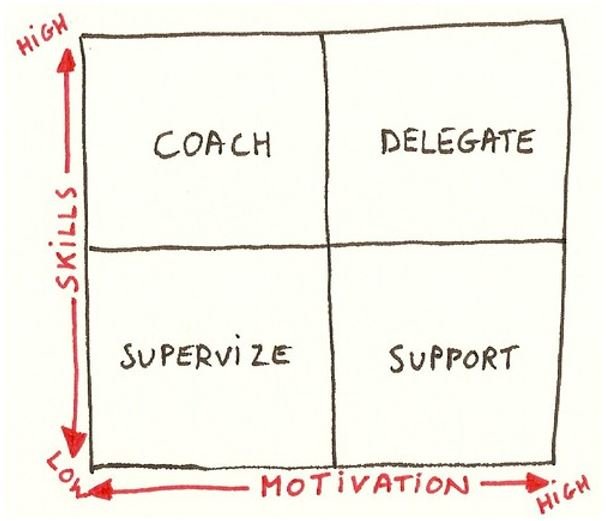What is the Skill Will Matrix?
What is the Skill Will Matrix?
Definition: Skill Will Matrix is a method that helps managers use the correct management style with people who have different levels of Ability and Motivation (Skill and Will).
How does the Skill Will Matrix work?
When using the Skill Will Matrix, we measure people against two fundamental criteria:

- SKILL: their level of native ability, education, knowledge, training and experience.
- WILL: their level of motivation, commitment, dedication and determination.
If we use SKILL and WILL as two base lines for a Matrix, then we can draw a 2x2 grid that generates four categories of worker, and four corresponding management styles.
Let us look at the four types of employees and the corresponding management styles:
Low Skill and Low Will.
These workers have low ability and low-level motivation. Consequently, our management style should be more directive and regulatory. We keep a close-eye on people who are in this group and we do whatever we can to train and motivate them.
We call this style of management, Supervisory.
Low Skill, High Will.
This means employees have low ability, but are highly motivated and committed. Consequently, our management style should be more focused on training new skills and building their knowledge and experience. They are willing to learn, so this is rewarding work.
We call this style of management, Supportive.
High Skill, but Low Will.
Which means they have a lot of ability, knowledge and experience, but have negative emotions, are cynical and demotivated.
Consequently, our management style is focused on motivating them to give us their best efforts, which we do by using incentives and encouragement.
We call this management style, Coaching.
High Skill, High Will.
This means staff have a great deal of ability, knowledge and experience, combined with a high degree of self-motivation and confidence. Consequently, we use a management style which allows them maximum freedom to express their creative talents.
We manage this group using a very light touch, because these people can manage themselves. So, we call this management style, Delegating.
How to use the Skill Will Matrix when recruiting
Recruiters should use the Skill Will Matrix in this way:
1. Prioritise your recruitment search to find High Skill Will candidates.
Determining high skill is easier than determining high will, because skill is an objective measure which can be verified by a person's educational qualifications, past achievements, and track record.
Determining high will is not easy because people put on a good performance at an interview and can fake a good attitude.
Consequently, recruiters should think carefully about what questions would give a reliable measure of an interviewee's genuine level of desire, commitment and will, to add value to an organisation.
2. Give second priority to Low Skill, High Will candidates.
Willing workers can easily be taught new skills, since they are willing to learn. Ensure they have the sufficient basic intelligence and education that permits them to learn necessary new skills.
We prioritise Low Skill, High Will because it is much easier to teach new skills, knowledge and information, than it is to try to motivate highly skilled, but cynical and negative people.
3.Give third priority to High Skill, Low Will candidates.
It is easy to justify employing people based upon their high skills, and it is tempting to do so.
But if High Skill, but Low Will, employees employ enter a workplace (ie they are cynical, disinterested, negative and lazy) then they cause more trouble than their skills are worth.
4.Deselect those prospects who fall into the category of Low Skill and Low Will.
Obviously, employers do not want people who have both low skills and a don't care attitude.
Leadership and Management Training
To learn more about inspirational management techniques, please attend our two-day Leadership and Management Training Course.
Definition: Skill Will Matrix
In management, the Skill Will Matrix is a four-box framework that helps leaders pick the right approach for each person. It plots skill on one side and will on the other, placing staff into one of four groups. Each group links to a set action: supervise, support, coach or delegate. The tool guides daily leadership and fair hiring.
Show CG4D Definition
- plots every worker’s skill on one axis and will on a second axis
- forms a simple 2×2 grid that yields four distinct worker types
- attaches a matching management style to each worker type
- directs leaders in coaching, supervision, delegation and hiring actions
Article Summary
The Skill Will Matrix proves that if you weigh each worker’s skill and will, then match them with supervision, support, coaching or freedom, you lift effort, results and hiring success.
Frequently Asked Questions
Here are some questions that frequently get asked about this topic during our training sessions.
What does the Skill Will Matrix measure?
How do I place a worker on the Skill Will Matrix?
Which management style suits low skill and low will staff?
How should I manage high skill but low will employees?
Why prioritise low skill, high will candidates in hiring?
Can someone move between quadrants on the Skill Will Matrix?
What is the main benefit of using the Skill Will Matrix?
Thought of something that's not been answered?
Did You Know: Key Statistics
Gallup’s 2023 State of the Global Workplace report finds that only 23% of employees are engaged at work, yet teams with high engagement see 18% higher productivity and 43% lower turnover. LinkedIn’s 2024 Workplace Learning Report shows that 83% of companies now put skills-based hiring above degree requirements, up from 64% in 2021.Blogs by Email
Do you want to receive an email whenever we post a new blog? The blogs contain article 5-10 minutes long - ideal for reading during your coffee break!
Further Reading in Leadership and Management
-
Three Advanced Leadership Skills
Learn three advanced leadership skills that let you turn any event into an edge: use what happens, adapt to change, and create new paths faster than rivals.
Read Article > -
Leadership and management development
Learn how leadership communication that mixes clear facts with motivating emotion lifts productivity, cuts turnover, and turns groups into winning teams.
Read Article > -
The Double-Edged Sword of Humour in Business
Learn how skilful humour in leadership lifts morale, sparks creativity and drives output, plus simple rules that stop workplace humour from harming respect.
Read Article > -
Leadership Skills: Keep Calm and Carry On
Learn leadership skills that turn uncertainty into chance. Keep calm, think clear, find new markets and guide your team to profit in a post-Brexit world.
Read Article > -
What New Team Leaders Should Do First
New team leader tips: study the setup, clarify goals, fit into the culture and drive ongoing improvement to win trust and deliver early success from day one.
Read Article >
Looking for Leadership and Management Training?
If you're looking to develop your Leadership and Management Skills, you may find this Leadership and Management Training Course beneficial:
Open Training Course Pricing and Availability
Next Open Course Starts in 37 days, Cardiff, places available






